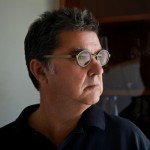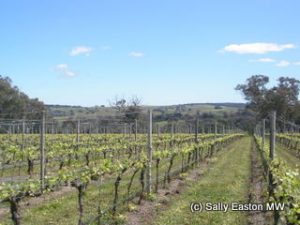Castagna

Julian Castagna
Ex-film director Julian Castagna, who learnt his love of wine in 1970s London – when the classics were affordable – bought his vineyard land in Beechworth, Victoria, in 1997, planting shiraz, sangiovese and viognier, with nebbiolo following in 2001 ‘because it is one of the great wines of the world’, he said. His reason for planting sangiovese is equally poetic “I walked on the land [at Beechworth] and thought I was in Montalcino, Tuscany.”
Before taking the plunge, Castagna had gained several years’ hands-on experience with illustrious and iconic immediate neighbour Rick Kinzbrunner at Giaconda. His first vintage was in 1998, using bought-in fruit, and 1999 marked the first of his estate wines, which are single vineyard wines, biodynamically grown. He is not certified, but is a member of the Return to Terroir / Renaissance des Appellation group, a collection of nearly 200 certified and non-certified biodynamic producers from all over the world.
The four hectare vineyard is northerly-facing, and Castagna plans to reach a maximum of six hectares. Soils are granitic loams with quartz crystal particles, and Castagna said “when the [biodynamic] preparations are used correctly, they allow the vines to access stuff that in the soils.”
In 2010, Castagna took delivery of some concrete egg-shaped vats, with which to experiment. He said “the eggs allow the wine to move” without getting any ‘dead’ areas as can be found in rectangular shapes. The plan, he said, was to put Genesis-destined [his flagship wine] shiraz and viognier into the eggs. “I expect another layer of complexity from them” he said “Aat the level of wine that we make, to try and increase quality by even 1% is worthwhile.”
Castagna always says he’s an intuitive winemaker, not a scientist, but his reasons for experimenting are sound “I can’t give a scientific reason, I do it because it tastes right.” No arguments there.

Castagna's vineyards
Many of the wines coming out of Beechworth show delightful flavours, which can partly be attributed to the cooler climate. The region’s heat degree days (HDD) range from 1240 to 1687, with it’s mean January temperature (MJT) ranging from 19.9°C to 20.4°C, which puts Beechworth across Amerine and Winkler’s Regions I and II. Castagna said “cool climate Australia is where great wines will be made. We’re still working out who we are and what land works best and why. But it truly is about the land.”
The Beechworth vineyards also have the benefit of being around 500m above sea level. “Obviously,” Castagna said “we’re not as cool climate as Tasmania, parts of the Yarra Valley, the Macedon Ranges, but we get cool nights during the ripening phase. During the day it can be as high as 30°C to 35°C, then it drops to 10°C and sometimes less [at night]. Vines love that.”
Tasting the wines I found a silky fineness to the tannins, which Castagna explained as being “in the vineyard. At 13.2% there isn’t enough flavour, the tannins aren’t ripe. At 13.5% they are. Generally at 14.5% they’re fat,” adding “I make shiraz the way most people make pinot noir. We only pick ‘til 11am. The fruit is always cold when it comes in. I do a cold soak of up to 6 days pre-fermentation, with whole bunches and whole berries.”
His aim, he said is to make “wine that plays with your brain. I think our wines have an energy, a spirit of their own. And this life comes from the vineyard.”
Castagna’s son Adam is the assistant winemaker, who also makes his own label, Adam’s rib, from both estate fruit and bought-in fruit.
Tasting notes, in situ, October 2010
Adam’s Rib, White 2008, $35
14%; chardonnay 70%, viognier 30%. On lees for 18 months with a little stirring.
Dry honey note, sweet melon, nice leesy texture. Tropical fruit, with apricot, nice density.
Castagna, Ingenue 2008 $55
14%; viognier
Vibrant pale gold, reticent peach and apricot blossom nose, smooth textured attack, fine oak texture which supports the fresh and full body, with defining acid core. Not an ounce of flab on the wine. Has an elegance along with linear profile and lovely balance.
Castagna, Allegro 2009 $30
14% syrah rosé. Same fruit as use in Genesis.
Pale, salmon colour. Warm strawberry nose, followed on palate with attractive weight, and slippery texture in fully dry style. Has a certain restraint, which opens up in the mouth.
Adam’s Rib, The Red 2008 $35
14%; nebbiolo (60%+), syrah
Medium pale colour. Aromatic cherry fruit on the nose, quite enticing. Something dark and herbal at the back of the nose. Palate gently spiced red cherry, sweet-sour, smooth, fine-layered tannin, fresh core. Nothing fleshy and fat but all nicely ripe. Elegant balance, and really tasty in a medium body which integrates the alcohol completely in layers of tannin. Very good.
Castagna, Genesis 2008 $75
14%; 98% syrah; 2% viognier.
Medium deep ruby red. Aromatic tar, plum and dark perfume. Smooth, dark, silky palate attack, just sweet fruit, in cool spectrum of silky black fruit. Dense fruit layers, hints of graphite retronasally, a delight to hold in the mouth and let flavours emerge. Long finish. Dry and youthful.
Castagna, Un Segreto 2005 $75
13.5%; 60% sangiovese, rest syrah.
Herbal cherry and plum nose. Bright and perky cherries in medium bodied wine whose tannins have a sweet-chalky grip. Dark fruit, berries, dark spices,with sweet core of fruit, as well as freshness. Complex and layered with, with not a sign of age, and a fresh finish.



